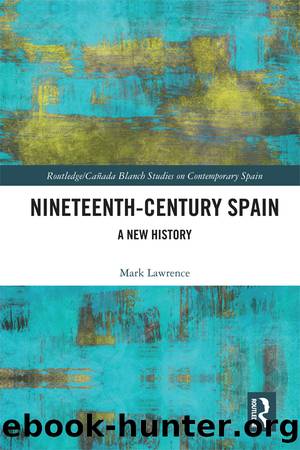Nineteenth Century Spain by Lawrence Mark;

Author:Lawrence, Mark; [Неизв.]
Language: eng
Format: epub
Publisher: Taylor & Francis (CAM)
Published: 2019-06-09T20:00:00+00:00
Chapter 4
1844â68: search for security
This chapter shows how the civil war legacy of eroded obedience to the state, combined with army officersâ political pretensions, meant that Princess Isabella, declared of age as queen in 1844, faced an impossible reign. She was the first constitutional monarch in Spanish history and a woman in a context of prevailing gender attitudes and military strongmen. The cause of Isabella and her mother in the First Carlist War had opened a period of praetorianism in Spanish history that culminated in the civil war one hundred years later. Victory over Carlism in 1840 undermined civilian supremacy in the liberal state. Just like her father during the Peninsular War, Isabella could not live up her propaganda image forged during the Carlist War. The âinnocentâ princess turned worldly soon after coming of age in 1843. Her crown was the lynchpin of a dysfunctional party system which rendered both ârestrainedâ liberals (moderados) and, to an even greater extent, âadvancedâ liberals (progresistas) beholden to military champions to get them into power. The veteran generals of the Carlist War dominated ministerial politics. âPronouncingâ in favour of political change could yield promotions to officers and leave for men, if executed successfully. Failure did not have to mean the ultimate penalty. The army retained a âgentlemanlyâ attitude towards its politics and the queen herself felt no particular duty to honour civil supremacy. Even though the civil war against the Carlists had been waged in the name of liberalism, the victors, beginning with the queen herself, retained remarkably illiberal political and social values. A British obituary of the queen, coming from the foreign country which had done the most to ensure her victory in the 1830s, captured this situation perfectly, as the leading generals of her day: âwhatever their mutual dissensions ⦠were always interested in keeping her on the throne as an instrument of their own powerâ.1
Women had not been entirely excluded from the liberal public sphere before the young queen came to symbolise it. Women had participated in the Patriotic Societies of the Triennium (1820â23) and in a number of philanthropic initiatives during the Carlist War, while the defence of hearth and home inherent in the Patriot propaganda and (to some extent) the reality of the Peninsular War placed women at the centre of the war effort.2 Unlike Queen Victoria in Britain, Isabella failed to master the symbolic trappings pertaining to Spainâs new constitutional monarchy and could not channel her barely concealed absolutist and religious instincts in strategic directions. The queenâs discomfort symbolised a wider insecurity in the new liberal society. âRespectableâ politics remained the preserve of a small number of wealthy men and their patronage networks, wives and daughters remaining outside the political nation and within the realm of family, religion, and morality. The right-liberal Moderado party set the tone for this era, centralising politics and public order and staying in power except during the progresista 1854â56 Biennium and the 1858â63 centrist âLiberal Unionâ. General Esparteroâs progresistas sought to expand the
Download
This site does not store any files on its server. We only index and link to content provided by other sites. Please contact the content providers to delete copyright contents if any and email us, we'll remove relevant links or contents immediately.
The Japanese by Christopher Harding(1022)
Watercolor With Me in the Forest by Dana Fox(717)
A Theory of Narrative Drawing by Simon Grennan(708)
The Story of the Scrolls by The Story of the Scrolls; the M(696)
Glittering Images: A Journey Through Art From Egypt to Star Wars by Camille Paglia(636)
Boris Johnson by Tom Bower(597)
The Art and Science of Drawing by Brent Eviston(564)
This Is Modern Art by Kevin Coval(563)
Frida Kahlo by Frida Kahlo & Hayden Herrera(555)
AP Art History by John B. Nici(543)
Banksy by Will Ellsworth-Jones(539)
Van Gogh by Gregory White Smith(521)
War Paint by Woodhead Lindy(520)
Scenes From a Revolution by Mark Harris(514)
Draw More Furries by Jared Hodges(509)
Ecstasy by Eisner.;(501)
About Looking by John Berger(499)
100 Greatest Country Artists by Hal Leonard Corp(498)
Young Rembrandt: A Biography by Onno Blom(486)
